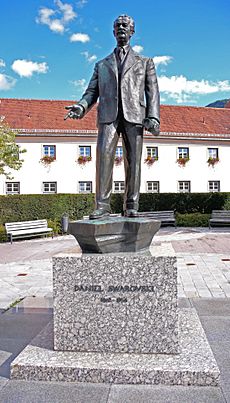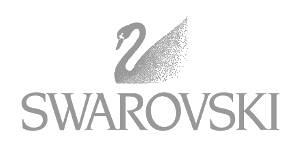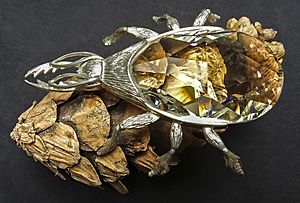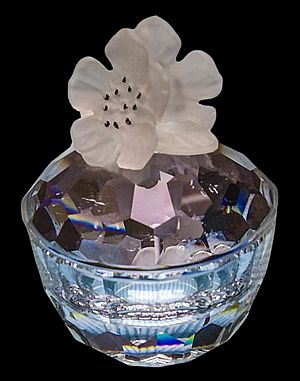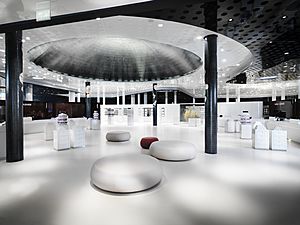Swarovski facts for kids
| Kommanditgesellschaft (private company) | |
| Industry | Fashion, crystal, and jewelry |
| Founded | 1895 (as A. Kosmann, D. Swarovski & Co.) |
| Founders |
|
| Headquarters | Wattens, Innsbruck-Land District, Austria |
|
Area served
|
Worldwide |
|
Key people
|
|
| Products | Crystal, genuine gemstones, created stones, accessories, and lighting |
| Revenue | €2,700,000,000 |
|
Number of employees
|
~29,000 (2020) |
Swarovski is a famous company from Austria that makes beautiful products from a special type of glass called crystal. The company is based in a town called Wattens. It was started in 1895 by a man named Daniel Swarovski.
Swarovski is known for making sparkling jewelry, accessories, and small statues. But the company is split into three main parts.
- The Swarovski Crystal Business makes crystal glass, jewelry, and watches.
- Swarovski Optik makes tools like telescopes and binoculars.
- Tyrolit makes tools for grinding, sawing, and drilling.
The crystal part of the business is the largest. It has around 3,000 stores in 170 countries. For a long time, the company was run by the Swarovski family. But recently, people from outside the family have started to lead the company.
Contents
The Story of Swarovski
The story of Swarovski begins with its founder, Daniel Swarovski. He was born in a village in northern Bohemia, which is now part of the Czech Republic. His father was a glass cutter who owned a small factory.
As a young man, Daniel learned the art of glass-cutting from his father. In 1892, he invented and patented an electric machine. This machine made it much easier and faster to cut crystal glass with great precision.
A New Beginning in Austria
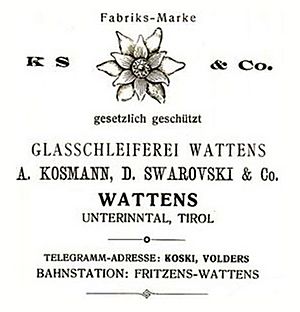
In 1895, Daniel Swarovski started his own company with two partners. They built a factory in Wattens, a town in the mountains of Tyrol, Austria. They chose this spot to use the power from the local rivers (called hydroelectricity) to run their machines.
Daniel's dream was to make "a diamond for everyone." He wanted to create beautiful, sparkling crystals that were affordable for many people. His new machines helped make this dream come true.
Growing the Business
The company grew quickly. In 1899, it started using an edelweiss flower as its logo. In 1919, Swarovski started a new company called Tyrolit. It used the same technology for grinding and polishing crystals to make tools for other industries.
Later, in 1935, Daniel's son Wilhelm created a special pair of binoculars. This led to the start of Swarovski Optik in 1949. This part of the company makes high-quality optical instruments like binoculars and telescopes.
A Difficult Past
During the 1930s and 1940s, some members of the Swarovski family were supporters of the Nazi party in Germany and Austria. Before and during World War II, the company worked with the Nazi government. This support helped the company grow and add new products during the war.
After the war, company leader Alfred Swarovski explained that he worked with the party to protect the business. In recent years, the company has started to look into its history from this time to be open about its past.
What Does Swarovski Make?
Swarovski is most famous for its crystal products. These include glass sculptures, small figurines, jewelry, rhinestones, watches, and home decorations like chandeliers.
All official Swarovski sculptures have a logo. The first logo was an edelweiss flower. This was later changed to the letters S.A.L. and then, in 1988, to the famous swan logo we see today.
How Are the Crystals Made?
Swarovski crystals are made by melting a mix of quartz sand and other minerals at very high temperatures. In the past, lead was used to make the glass sparkle, but since 2012, all Swarovski crystals are lead-free.
To get the amazing rainbow effect, some products are coated with special metallic chemicals. One of the most famous coatings is called Aurora Borealis, or AB. It gives the crystal surface a shimmering, rainbow-like appearance.
The company also created a special cut called Xilion. This cut has many facets (or flat surfaces) that make the crystal extra brilliant and shiny.
Swarovski in the World
Swarovski is more than just a crystal company. It has many different parts that do different things.
- Swarovski Optik: Makes high-quality binoculars, telescopes, and rifle scopes.
- Tyrolit: Creates tools for cutting and grinding.
- Swarovski Gemstones: Works with both natural and human-made gemstones.
- Atelier Swarovski: Works with famous designers to create special jewelry and home decor collections.
The Crystal Worlds Museum
The company has its own museum called Swarovski Kristallwelten (Crystal Worlds). It is located at the original factory site in Wattens, Austria. The entrance to the museum is a giant, grass-covered head with a fountain for a mouth. Inside, visitors can see amazing art installations made with Swarovski crystals.
Swarovski in Movies and Fashion
Swarovski crystals are very popular in the entertainment world. They have been used to add sparkle to movies, stage shows, and fashion.
On the Big Screen
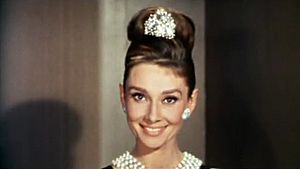
You can see Swarovski crystals in many famous films:
- The "Heart of the Ocean" necklace in Titanic was made with a Swarovski crystal.
- The sparkling costumes in Moulin Rouge!.
- The glass slipper in the live-action Cinderella was made entirely from Swarovski crystals.
- The crown worn by Rami Malek as Freddie Mercury in Bohemian Rhapsody.
- The jewelry worn by Marilyn Monroe in Gentlemen Prefer Blondes.
On Stage and on the Runway

Swarovski crystals are also a favorite of costume designers for concerts and theater.
- Musicians like Madonna and Rihanna have worn costumes covered in thousands of crystals on their tours.
- The famous crystal glove worn by Michael Jackson was made with Swarovski crystals.
- For many years, Swarovski has worked with the Victoria's Secret Fashion Show, creating dazzling outfits and wings decorated with crystals.
Famous Partnerships
Swarovski often works with other brands and events.
- Since 2004, the giant star that sits on top of the Rockefeller Center Christmas Tree in New York City is made by Swarovski. It is nearly 3 meters wide and covered in millions of crystals.
- The company has worked with brands like Dior on museum exhibitions and with Skims on a collection of body jewelry.
- Swarovski has also partnered with Marvel to create a collection of figurines of famous superheroes.
Images for kids
-
Actress Penélope Cruz wearing a dress with Swarovski crystals.
-
Marilyn Monroe wearing sparkling Swarovski crystals in Gentlemen Prefer Blondes.
-
Swarovski store in Frankfurt, Germany.
-
Swarovski store in Munich, Germany.
-
The Swarovski headquarters in Wattens, Austria.
-
Swarovski store in Zagreb, Croatia.
-
Swarovski sign at the airport in Delhi, India.
See also
 In Spanish: Swarovski para niños
In Spanish: Swarovski para niños
- Swarovski Kristallwelten (Crystal Worlds)


